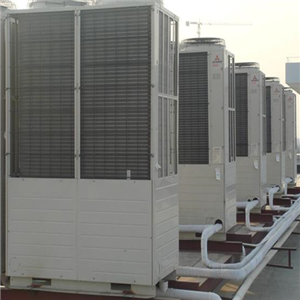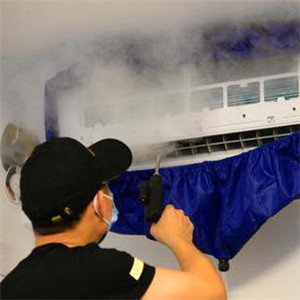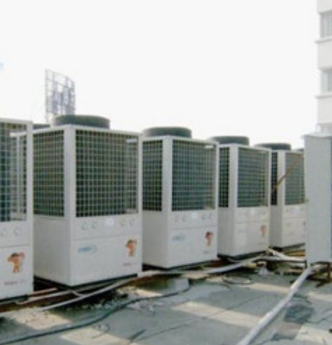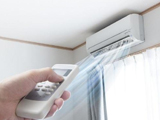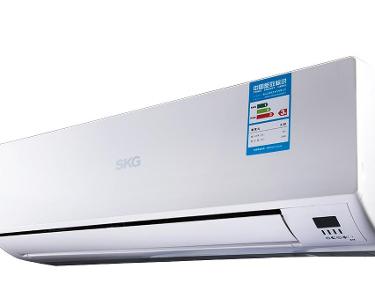Household air conditioner
Air conditioners are divided into single cooling air conditioners and dual-use air conditioners. The working principle is the same. Most of the refrigerants used in air conditioners before were Freon. Freon is characterized by releasing a lot of heat when it changes from a gaseous state to a liquid state. When the liquid state changes to the gas state, it will absorb a lot of heat. (i.e. endothermic gasification before liquefaction and exothermic) Air conditioning is designed according to this principle.
The compressor compresses the gaseous refrigerant into high-temperature and high-pressure gaseous refrigerant, which is then sent to the condenser (outdoor unit) for heat dissipation and becomes the liquid refrigerant with normal temperature and high pressure, so the outdoor unit blows hot air.
Then it goes to the capillary tube and enters the evaporator (indoor unit). Since the space suddenly increases after the refrigerant reaches the evaporator from the capillary tube and the pressure decreases, the liquid refrigerant will vaporize and become a gaseous cryogenic refrigerant, thus absorbing a lot of heat, and the evaporator will become cold. The fan of the indoor unit will blow the indoor air through the evaporator, So the indoor unit is blowing cold air; The water vapor in the air will condense into water drops after encountering the cold evaporator and flow out along the water pipe, which is the reason why the air conditioner will produce water.
During heating, there is a component called four-way valve, which makes the flow direction of refrigerant in the condenser and evaporator opposite to that during cooling. Therefore, during heating, cold air is blowing outdoors, and hot air is blowing indoors.
In fact, it is based on the principle learned in junior high school physics that heat should be discharged when liquefying (from gas to liquid) and heat should be absorbed when vaporizing (from liquid to gas).
Operating principle of environment-friendly air conditioner:
The circulating water pump is used to draw out the water in the water tank without interruption, and the water distribution system is used to spray the water evenly on the evaporation filter layer. The outdoor hot air enters the evaporation cooling medium, and the heat exchange with the water is fully carried out in the evaporation cooling medium CELdek (honeycomb filter layer made of special materials, making the cooling effect more ideal, Sweden's high-tech patented product), Cool and clean air cooled by water evaporation and heat absorption is pressurized into the room by low-noise fan, so that the indoor hot air is discharged to the outside, so as to achieve the purpose of indoor cooling.
central air-conditioning
1、 Refrigeration principle of central air conditioning: compression type, absorption type, etc.
2、 Heating principle of central air conditioning.
3、 Principle of central air conditioning system: working principle of air system, working principle of water system, working principle of coil system, etc.
1. Refrigeration principle
Liquid vaporization refrigeration is realized by the heat absorption effect of liquid vaporization and the heat release effect of liquid condensation. The liquid vaporizes to form vapor. When the liquid (refrigerant) is in a closed container, there is no other gas in the container except the liquid and the vapor generated by the liquid itself. The liquid and vapor will reach equilibrium at a certain pressure. At this time, the vapor is called saturated vapor, the pressure is called saturated pressure, and the temperature is called saturated temperature. When the liquid is in equilibrium, it will no longer vaporize. At this time, if some steam is pumped from the container, the liquid must continue to vaporize to generate some steam to maintain this equilibrium. When liquid vaporizes, it shall absorb heat, which is called latent heat of vaporization.
The latent heat of vaporization comes from the cooled object, which makes the cooled object cool. In order to make this process continuous, it is necessary to continuously extract steam from the container, and make it condense into liquid before returning to the container. If the steam extracted from the container is directly condensed into steam, the temperature of the cooling medium required is lower than the evaporation temperature of the liquid. It is hoped that the condensation of the steam is carried out at normal temperature, so the pressure of the steam needs to be increased to the saturation pressure at normal temperature.
The refrigerant will evaporate at low temperature and pressure, resulting in cold effect; And condense under normal temperature and high pressure to release heat to the surrounding environment or cooling medium. Steam becomes high-pressure liquid after condensation at normal temperature and high pressure, and its pressure must be reduced to evaporation pressure before entering the container.
Liquid vaporization refrigeration cycle is composed of four processes: working medium vaporization, steam pressure rise, high-pressure steam condensation and high-pressure liquid pressure drop.
2. Heating principle
The low-pressure gas inhaled by the compressor is compressed into high-temperature high-pressure gas by the compressor. The high-temperature gas heat exchanger increases the water temperature, and the high-temperature gas will condense into liquid. The liquid enters the evaporator for evaporation. (The evaporator also needs heat exchange media. According to the heat exchange media, the model and structure of different machines are different, and the commonly used ones are air cooling and ground source.) After the liquid passes through the evaporator, it becomes a low-pressure and low-temperature gas, which is sucked into the compressor again for compression.
In this way, the circulating water on the air conditioning side will become hot water of about 45-55 degrees. The hot water is sent to the room that needs heating through pipes, and the room is equipped with fan coil units to heat exchange the hot water and air for heating purposes.
3. System principle
Working principle of water system
The water-cooled central air conditioner consists of four parts: compressor, condenser, throttling device and evaporator. The refrigerant circulates in the above four parts in turn. The refrigerant (refrigerant) gas with high temperature and pressure from the compressor flows through the condenser to cool and depressurize. The condenser cooling water system brings heat to the cooling tower for discharge, and the refrigerant continues to flow through the throttling device, It becomes a liquid with low temperature and pressure, flows through the evaporator, absorbs heat, and then is compressed.
The two ends of the evaporator are connected with a chilled water circulation system. The heat absorbed by the refrigerant this time lowers the temperature of the chilled water, making the low-temperature water flow to the user end, and then heat exchange through the fan coil to blow out the cold air.
Working principle of air system
The transmission mode of fresh air is displacement, instead of the internal circulation principle of air conditioning gas and the unhealthy practice of mixing new and old gas, the outdoor fresh air will be automatically sucked into the room through the negative pressure mode, and when it enters the room through the new air outlet installed on the window of the bedroom, living room or living room, it will automatically remove dust and filter. At the same time, the corresponding indoor pipeline is connected to the exhaust outlets in several functional rooms, and the formed circulation system will take away the indoor waste gas and concentrate it on the exhaust outlet for "exhalation", while the exhaust gas will not be recycled any more, and the old and new wind will circulate well.
Operating principle of coil system
The working principle of the fan coil unit air conditioning system is to continuously circulate the indoor air with the help of the fan coil unit, so that the coil unit can be cooled or heated to maintain the required temperature and certain relative humidity of the room.
The cold or hot water used by the coil is supplied by the centralized cold source and heat source. At the same time, the fresh air, which is centrally processed by the fresh air air-conditioning room, is sent to each air-conditioning room through special fresh air ducts to meet the sanitary requirements of the air-conditioning room.
Compared with the centralized system, the fan coil unit air conditioning system has no large air duct, only water pipes and small fresh air ducts. It has the advantages of convenient layout and installation, small occupation of building space, good independent adjustment, etc. It is widely used in comfort air conditioning that requires independent control due to low temperature and humidity accuracy requirements, large number of rooms, small rooms, and small number of rooms.

